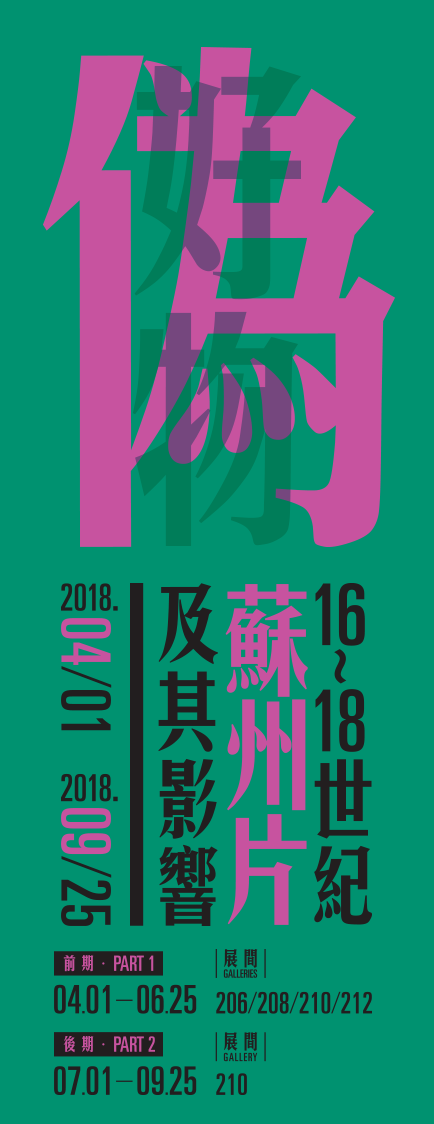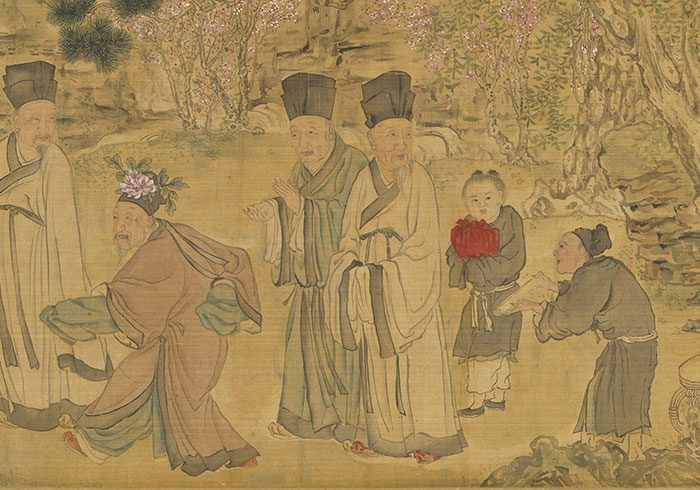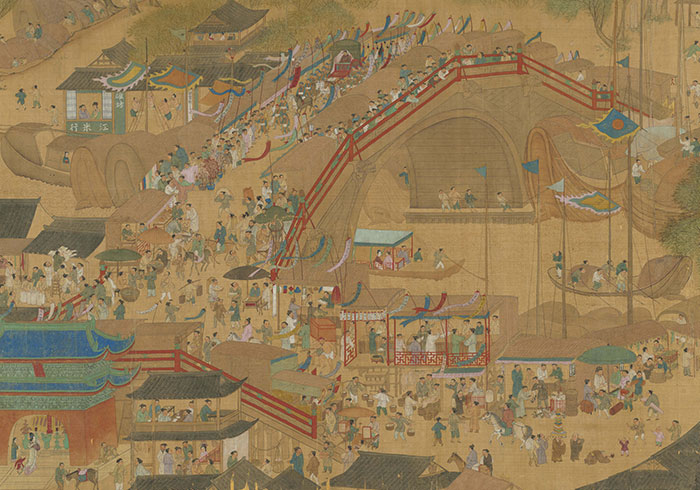According to miscellaneous notes and stories, in the Ming dynasty the notorious Grand Secretary Yan Song (1480-1567) and his son coveted the handscroll painting of "Up the River on Qingming" by the Northern Song artist Zhang Zeduan (fl. early 12th c.), learned it was in the possession of the official Wang Yu (1507-1560), and demanded it from him. Unwilling to relinquish his prized work, Wang surreptitiously commissioned the artist Huang Biao (1522-after 1594) to make an exact copy and offered it instead. Yan and son thereupon reveled at acquiring the painting, considering it the best work in the family collection. Later, the mounter of the forgery, Tang Chen, unsuccessfully tried to extort money from Wang Yu, and the deception was revealed. Furious at being cheated, Yan and son had Wang Yu framed and ultimately beheaded in revenge.
This story of literally "dying for a painting," which comes in many versions, involves characters from different levels of society, from the Grand Secretary down to an official, a painter, and a mounter. As it turns out, "Up the River on Qingming" as a "finery of forgery" by Huang Biao proved to be one of the most popular subjects among so-called "Suzhou fakes," demonstrating how this theme permeated almost every level of society at a time when the "craze for antiquities" and fineries of forgery became "trendy" consumer products among those with purchasing power.
The Nine Elders
- Huang Biao (1522-after1594), Ming dynasty
- Handscroll, ink and colors on silk, 27.2 x 193 cm
Huang Biao was a professional artist of Suzhou who excelled at making copies of paintings. Legend has it that he did an imitation of "Up the River on Qingming" to be presented to the powerful Grand Councilor Yan Song (1480-1567) and his son instead of the twelfth-century original by Zhang Zeduan of the Northern Song. Scholars believe that he is one of the few artists representative of "Suzhou fakes" who can be clearly identified.
This painting is the only surviving one personally signed by Huang Biao. Dated to the equivalent of 1594, it was done at the advanced age of 74 by Chinese account. The composition is actually similar to "The Nine Elders of Huichang," a painting attributed to Liu Songnian in the National Palace Museum collection that is an example of Huang Biao copying an ancient work. Huang's inscription on this handscroll compares the rise and fall of painting to that of worldly matters. And he saw his own reworking of "The Nine Elders" as "reviving (that which is all but) extinct," in other words playing a vital role in continuing and preserving the past.
Qingming in Ease and Simplicity
- Attributed to Zhang Zeduan (fl. early 12th c.), Song dynasty
- Handscroll, ink and colors on silk, 38 x 673.4 cm
Painted at the end of this scroll is a columnar rock, upon which is a signature that reads, "Submitted by Your Servant, Zhang Zeduan, Painter of the Hanlin (Academy)." Many of the shop signs in this painting, such as "Good-hand Sun's Steamed Buns" and "Pan's Milk-vetch Dumplings," correspond to the names of shops in Record of Dream Splendors at the Eastern Capital, a text from the Southern Song period of the Northern Song capital Kaifeng. However, the type of masonry used in the city wall here had not yet appeared in the Northern Song, and the depictions of landforms and vegetation reveal the influence more of Qiu Ying's (ca. 1494-1552) style. In addition, the combination of blue, green, and red washes for the buildings and palaces is typical of that found in "Suzhou fakes." Along with the spurious seals of Wang Shizhen (1526-1590) and Yan Shifan (1513-1565), these all point to this as being a late Ming dynasty work based on a Southern Song description of Bianjing (Kaifeng).
At the same time, it mentions Wang Shizhen's father and the famous story of "dying for a painting" involving Yan Song. Incorporating the bustling market atmosphere of that time, it makes for a careful (and innovative) Ming dynasty interpretation of the renowned "Up the River on Qingming" painting. The delicate delineation of the figures and their expressions as well as the bustling commercial activities are all marvelously rendered with great interest, making this a masterpiece among "Suzhou fakes."


